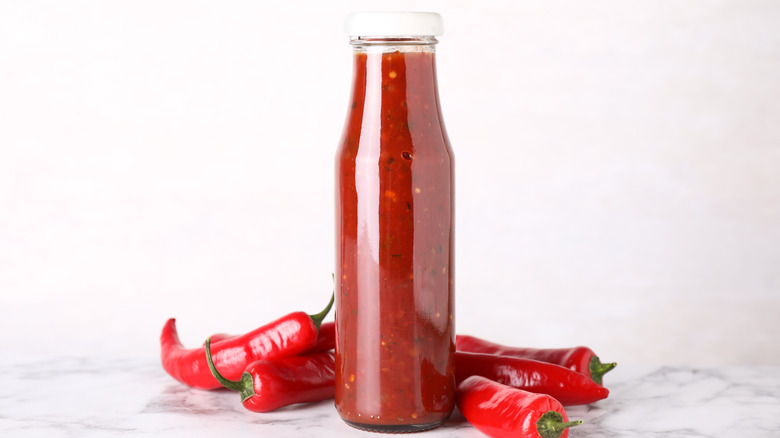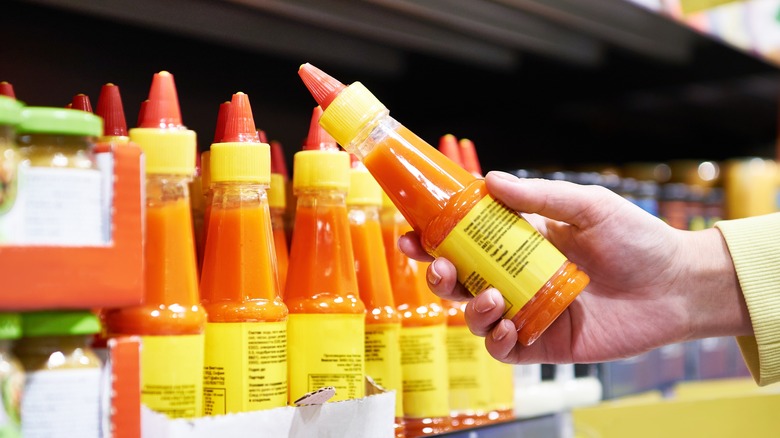Fridge Vs Pantry: The Best Way To Store Hot Sauce
Lovers of spicy food know that it's all too easy to amass a big hot sauce collection. Get swept up in trying the best hot sauces to pair with fish, tacos, burgers, fried rice, and much more, and you wind up with more bottles than you know what to do with. How do you keep all of them fresh, while overloading neither your fridge nor your pantry? Those of us who are short on fridge space will be glad to learn that not every hot sauce needs to be kept cold.
It's true that storing hot sauce in the fridge, especially after opening, will prevent changes in color or flavor over time. But depending on the ingredients in a sauce, storing your spicy condiments in the pantry could work, too. Lots of tangy hot sauces contain high amounts of acidic ingredients like lemon juice, vinegar, or sodium benzoate, which have preservative effects and ensure safe storage in the pantry. Just keep the bottles somewhere cool and dark to minimize changes in appearance or taste, which don't necessarily indicate spoilage, but are still best avoided.
On the other hand, if you've got room in the fridge and are generally slow to polish off a bottle, keep your hot sauces refrigerated. Fresh or fermented sauces in particular should be kept cold, as they can spoil and become unsafe to eat at room temperature. If you're still unclear on where your sauces should go, just look at the ingredients list.
The ingredients of hot sauce can tell you how to store it
A commercially-produced hot sauce with high concentrations of vinegar and salt, like Tabasco, Frank's Red Hot, sambal olek, or Tapatio, is usually safe to keep at room temperature. Sweeter sauces like Sriracha are also safe in the pantry – add that to the list of things you didn't know about it. Discoloration or subtle flavor changes are still apt to occur over time, especially if the sauce is exposed to heat or sunlight, but the salt and acid will keep harmful microbes from growing. Still, it's best to make sure your pantry is dark and none too warm.
Artificial preservatives also help out, but they're not a guarantee of safety. The style of a hot sauce has the most bearing on where it should be stored. Sauces made by smaller brands with fresher ingredients and fewer preservatives are more likely to require refrigeration. Think of sauces made of fresh chilis, garlic, and vegetables, instead of dried ingredients, chili powder, or artificial flavorings. Organic sauces often fall into this category. With less salt, sugar, and acidity, these products are more likely to foster bacteria.
Helpfully, many brands print storage instructions on their bottles that can also help you out. "Refrigerate after opening" is the phrase to look for. If there's no indication that the sauce needs to be stored cold, you can probably keep it in your pantry, though the refrigerator will help it last a little longer.
How to tell if a hot sauce is past its prime
Though most hot sauce brands offer recommendations on the right way to store their products and how long they stay fresh, use your best judgment and always inspect your sauce before you use it. Don't blindly rely on best-by dates — sometimes, your sauces go bad early for whatever reason, and need to be tossed.
Hot sauce has a reputation for lasting a long time, not only due to high acid or salt contents, but because of the capsaicin found in hot peppers. This compound not only makes peppers taste spicy, but prevents the growth of bacteria in the finished sauce. Generally, refrigerated hot sauces can be kept for one to two years after opening, while sauces kept in the pantry can last for up to six months. However, no amount of preservatives or capsaicin can make a sauce totally immune to spoilage.
The good news is that when hot sauce goes bad, it's not too shy about it. Some key indicators that it's time to replace a bottle include significant textural changes, mold spots, a rancid scent, or bubbles forming in a non-fermented sauce. If you notice even just one of these signs, it's time to toss the sauce out, no matter how far it is from its printed expiration date.



